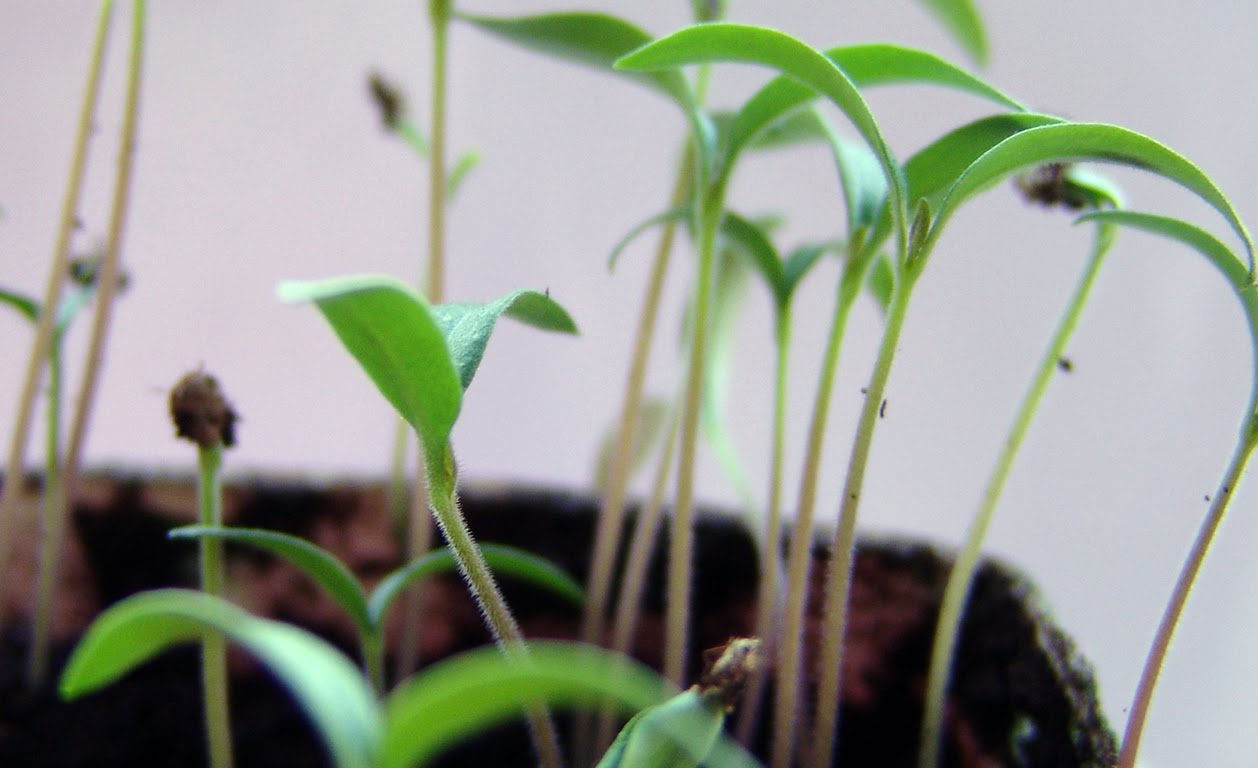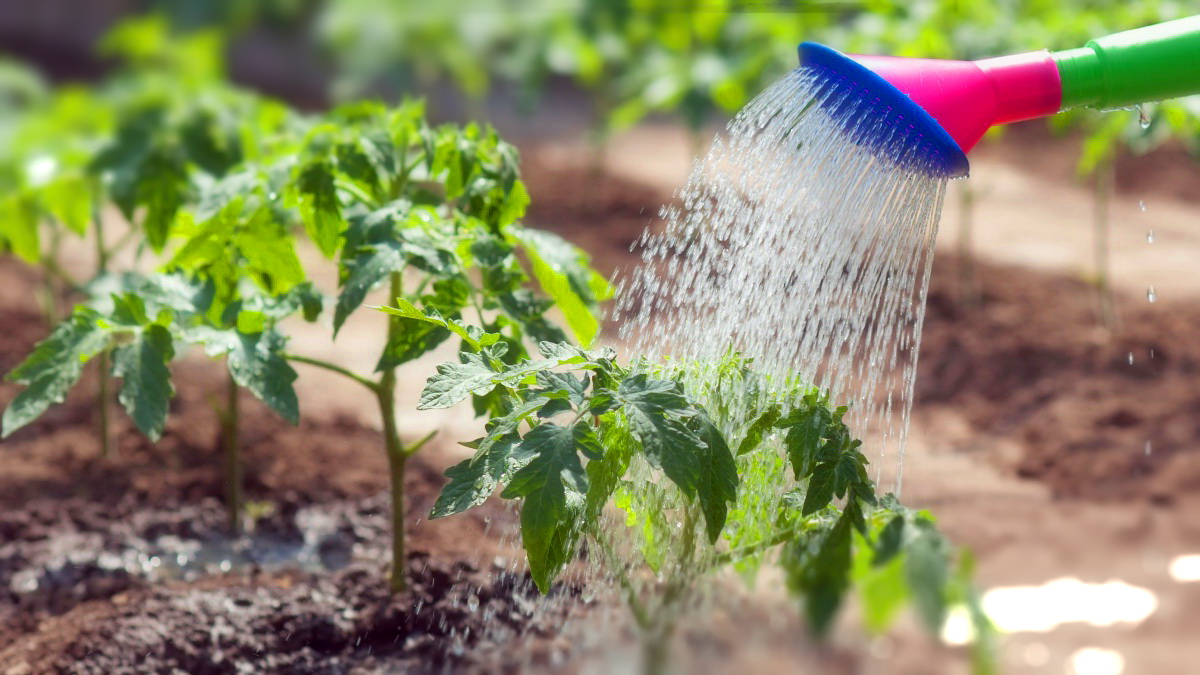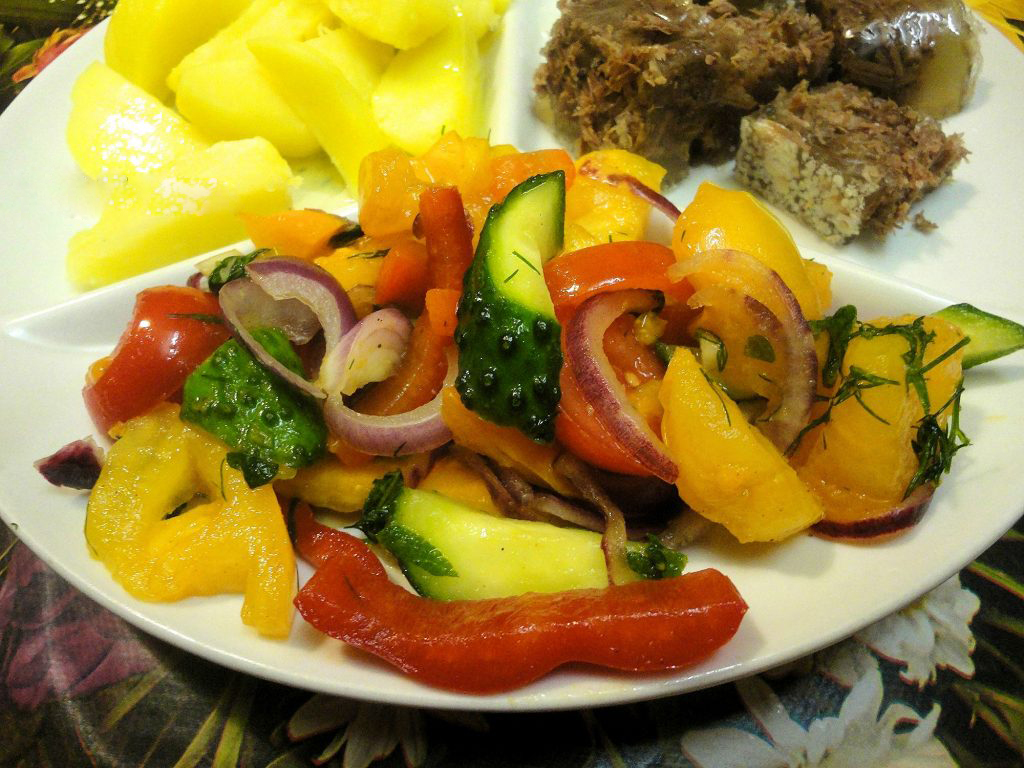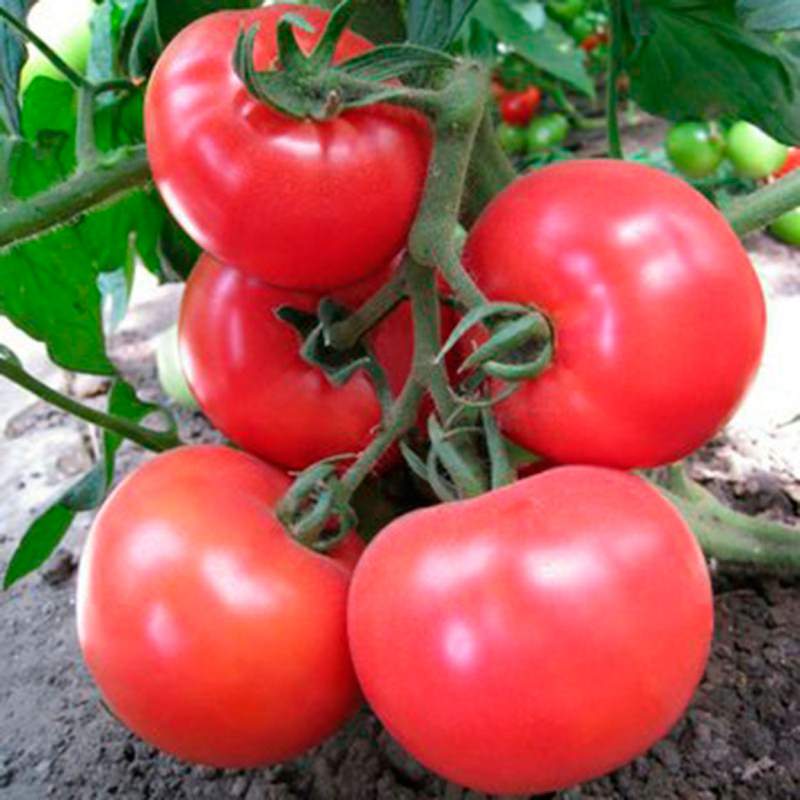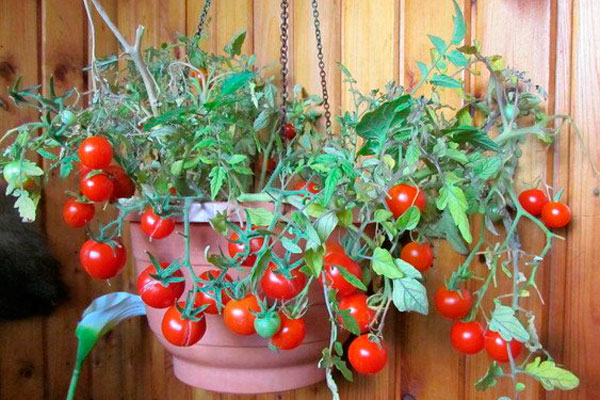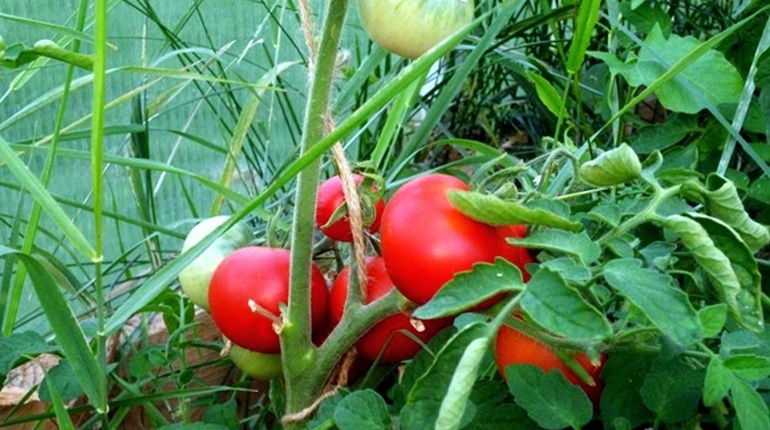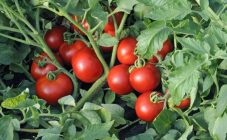Content:
Recently, a theory has emerged that a serving of colorful vegetables or fruits saves from depression and maintains the required balance in the body. Tomato varieties of different colors are popular among consumers.
Owners of vegetable gardens and summer cottages will love the Golden Fleece tomato. Cultivation will not take a lot of energy, and you can already taste the delicacy in July.
Description
This species was bred by breeders of the Poisk agrofirm 10 years ago. Officially entered in 2008 in the State Register of Breeding Achievements of the Russian Federation. Grown both in the greenhouse and in the open field. Cultivated throughout the country.
The determinant bush reaches 1 m or more in a favorable environment. In the garden, the height of the culture ranges from 40 to 60 cm.
According to summer residents, it is possible to grow up to 7 tomato bushes per 1 m2
open areas that develop and grow well. When the plantings are thickened, pinching will be required. With a more rare planting of plants - 4-5 bushes per 1 m2, do not stepchildren and do not tie up the bushes.
The culture has a powerful stem, small dark green leaves of standard dimensions, medium foliage. Form into 1 or 2 stems for yield. The first cluster is formed after 7 or 10 leaves, the next - every 3. There are usually up to 8 berries per 1 fruitful cluster. Fruits are elongated, with a characteristic spout. The stalk has a small depression. When ripe, they acquire an intense orange-yellow color. The flesh of the berries has a pronounced red color, reminiscent of an overseas fruit.
The growing season of a varietal self-pollinated vegetable takes at most 3 months, at least 80 days.
On average, the fruit weighs 100 g, in a greenhouse - 110 g. Remove from 1 bush - 1.5 kg, from 1 m2 of area - up to 9 kg.
Sweet to taste, with sourness. They are distinguished by resistance to mechanical stress during transportation, retain their marketable appearance. Do not crack. They are not afraid of temperature changes.
Consumed fresh for cutting into salads and making juice. The strength of the peel allows pickling and salting.
Frost resistance of tomatoes allows them to be zoned in Siberia and the Urals. They withstand slight frosts without shelter.
Beneficial features
The Golden Fleece is an excellent prophylactic agent for various pathologies:
- Vitamin A fights cardiovascular abnormalities and corrects vision, resists the development of cataracts;
- Systematic use strengthens the immune system, affects the condition of the skin, makes hair healthy and silky;
- Beta-carotene prevents the appearance of neoplasms.
How to grow
The technological process of planting the Golden Fleece is no different from other tomatoes.
In the fall, they begin to prepare the soil for vegetables. They dig up, add compost, ash, crushed egg shells. Choose a sunlit area. Heat refers to indicators that are mainly due to:
- growth rates;
- aging;
- harvest volume.
Soil moistening is less significant than warmth. The normal development of a tomato bush depends on air humidity: it does not exceed 50-60% (60-65% - in the first 3 months). If the relative humidity is high, then:
- the pollination of flowers becomes more complicated, they fall off;
- cultures are affected by fungal infections: black leg, late blight;
- plants are stretched;
- the yield goes down.
Light loam and sandy loam are ideal for growing vegetables.
When cultivating crops adhere to crop rotation: it is forbidden to plant after pepper and other plants from the Solanaceae family.The best predecessors for plants:
- cucumbers and carrots;
- zucchini and dill;
- parsley and cauliflower.
How to plant seedlings
By its ripening nature, the Golden Fleece is an early ripening vegetable. It is recommended to sow the planting material in the last decade of March or early April. The multi-stage seed planting method is noted.
Before planting, the seeds are calibrated: sick and damaged specimens are manually rejected. It is possible to use a solution that is prepared from 1 tbsp. l. kitchen salt and 1 liter of water. The seed is immersed in liquid for 5 minutes. The emergence of seeds to the surface indicates their unsuitability. Presowing treatment with growth stimulants is suitable:
- Immunocytophyte and Zircon;
- Ideal and Epin;
- Kornevin.
Seed material is wrapped in a light cloth and placed in the solution for 6 hours. The extracted seeds are only dried.
Fungicides are used to disinfect the planting material:
- Quadris;
- Aktobat;
- Ridomil.
Seeds undergo stratification 5 days before planting in a permanent place. They are placed on the bottom shelf of the refrigerator for half an hour. The residence time is gradually increasing and reaches 2 hours. The hardening process increases the plant's resistance to temperature fluctuations and increases yields.
Use soil from a store or prepare it yourself, mixing earth with coarse sand and humus in equal proportions. Add half a glass of wood ash. Fill the seedling containers. Watered with a slightly pink solution of potassium permanganate. Instead of chemical treatment, it is possible to heat the soil in an oven at 100 ºС.
The seeding depth of seeds is up to 1.5 cm, the distance from each other is 5 cm.
To speed up the emergence of sprouts, cover with polyethylene and place in a warm place. The film is removed when forming 2 sheets. They dive into individual cassettes, which are filled with new earth.
To prevent elongation of the plants, the container with the seedlings is turned over weekly in the opposite direction.
2 weeks before the planned planting, the seedlings are hardened. First ventilate the room where they are. Then they are taken out to the balcony or veranda for 15 minutes. The time spent on the street is gradually increased to several hours. Healthy seedlings have a rich green leaf color, growth is more than 20 cm. If you ignore this procedure, you will have to shelter the plants from the sun and wind until they take root.
Transfer
After 2 months, when 5-7 leaves appear on the seedlings, they are transplanted under a film shelter (second decade of May) or into open ground (early June). The wells are fertilized before planting the crop. Planted according to the scheme:
- the distance between crops is 40 cm;
- spacing in row spacing - 60 cm;
- planting density - 5-7 crops per 1 m2.
How to care
Caring for tomato bushes includes:
- watering;
- weed removal;
- loosening;
- top dressing;
- pest control.
Watering
Crops are rarely watered at the root, but abundantly. Use settled water.
What and how to fertilize
Caring for tomato crops provides for the introduction of fertilizing:
- A week or one and a half after planting in the garden. Use Sudarushka by adding 1 tsp. means in 10 liters of water;
- 21 days after planting in the soil. A suspension is prepared from 10 liters of liquid, into which the fermented mullein (500 ml), nitroammofoska (1 tbsp. L.) Are mixed. A half-liter can of fertilizer is applied under the vegetable;
- Flowering of the second brush. They are fed with a mixture of diluted chicken manure (200 ml), double superphosphate (1 tbsp. L.), Potassium sulfate (1 tsp.) In a bucket of water. Consumable volume - 1 liter for a bush;
- 2 weeks later. Superphosphate (1 tbsp. L.) Is dissolved in water (10 l). A bucket of fertilizer is required for 1 m2 of land;
- When pouring fruits at the end of July.For a 10-liter bucket, you will need potassium sulfate, superphosphate, nitroammophoska, which are taken in equal proportions - 1 tbsp. l. 500 ml is consumed per 1 bush.
If problems arise, proceed as follows:
- Sprinkling flowers. Sprinkle with boric acid (1 tsp) at the rate of 10 liters of liquid;
- Curling foliage. Use 100 g of superphosphate per bucket of water, 1 liter of solution per culture. The dosage of potash fertilizers is increased to 30 g per bucket of liquid;
- Growth retardation, pale color. Feeding is carried out with a mullein solution in a ratio of 1:10;
- Growing green mass, fattening plants to the detriment of fruit formation. Do not feed with nitrogen-containing fertilizers;
- Violet color of the leaves below. Signals about phosphorus deficiency;
- Drying of crops, variegated color of fruits. Talking about a lack of potassium. Excess - matte specks.
Loosening and weeding
Vegetables need to be periodically weeded to remove weeds and remove the lower leaves from the tops. Plants are also loosened and spud. This affects their development.
Diseases and pests
The main pests of the Golden Fleece include:
- spider mite;
- aphid;
- Colorado beetle.
Affected by fungal infections:
- fusarium;
- alterniosis;
- late blight.
The plant is immune to viral tobacco mosaic. Be sure to treat the bushes to protect against late blight three times with a break of 10 days. If necessary, use means of protecting vegetables from diseases and harmful insects.
When to clean up
Harvesting begins in mid-July and continues in August. Tear off green fruits before they are ripe with the threat of a cold snap and leave in a warm, but dark place.
Pros and cons of the variety
Benefits of the Golden Fleece:
- universal purpose;
- catchy appearance, suitable for the decor of any holiday;
- compact size;
- even dimensions of fruits;
- preservation of taste for a long time;
- disease resistance.
Minuses:
- yield from 1 bush;
- not the most remarkable, ordinary taste.
Description and characteristics of the tomato variety Golden Fleece will help novice gardeners grow an "orange miracle" at their summer cottage and enjoy the delicacy in the midst of the summer season.



